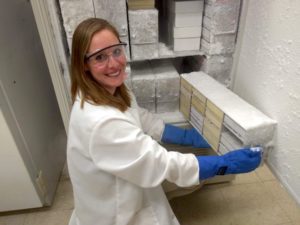
It sounds like something out of a science fiction movie: Rows of vials in a laboratory freezer, each containing detailed biological maps of what’s going on inside the bodies of dozens of horses at specific moments in time. The frozen blood samples might one day hold the keys to making racing clean and drug-free, predicting injuries before they happen and helping veterinarians fight illness with new and powerful tools. Sound too good to be true? Researchers at Penn Vet’s New Bolton Center hope it’s not.
The Center’s Equine Pharmacology Laboratory is in the process of gathering and analyzing data from racing Thoroughbreds — both those who have been seen at New Bolton for an orthopedic injury and horses active on the track – for its BioBank, a giant cache of stored, carefully-preserved samples. They hope one day the information could be used for biological passports, which have a number of potential uses in competition horses.
Biological passports would track biomarkers and proteins in a horse’s body over time. They could show natural or artificial changes which could signal an injury or disease or the horse’s reaction to a drug or other substance.
The BioBank project has received tremendous support from the Pennsylvania Horse Breeders’ Association (PHBA), which last year donated $300,000 to the lab as part of a tiered, multi-year project. PHBA executive secretary Brian Sanfratello said the organization’s support was based on concerns from its membership.
“Our board sent all the members a survey. We got quite a few back and set up a couple focus groups. We wanted to know what was important to breeders,” Sanfratello said. “There were quite a few things in the list but one of them was being able to race on a level playing field and making sure that the horses that we breed are not taken advantage of by medication and doping.”
“Once we did this we got together with Mary [Robinson, director of the Equine Pharmacology Lab] and basically said, ‘How can we help?’”
The PHBA is supporting the BioBank project generally, allowing New Bolton to purchase additional storage freezers for samples and funding a new staff position to help the clinic collect samples. But the group is particularly interested in the applications of biological passports to catching a new practice called gene doping.
How could someone possibly ‘dope’ a horse’s genes?
First of all, the phrase ‘gene doping’ may refer to two practices: gene editing, which involves changing the DNA before an animal is born to create something that didn’t form naturally, and gene therapy, which involves implanting a selected piece of DNA into an adult animal to increase natural production of a protein or other factor. Dr. Robinson said the first type of gene therapy became approved by the Food and Drug Administration two years ago for use in the human medical field, focusing on a hereditary retinal condition. There is still no FDA-approved type of gene therapy available for veterinary use, largely because research into the way it works is in the early stages.
There’s a lot researchers still don’t know about gene editing – including whether it’s been attempted on horses in competition settings. Scientists don’t know how often attempts at changing an animal’s genetic code may fail, or backfire if the genetic material gets inserted into the wrong place. And it’s not known how easy it would be for a horseman to find someone who knows how to perform the procedure.
It is possible to do gene editing in horses, but it’s also not unequivocally a bad thing. Robinson said some types of gene editing could be used appropriately in a therapeutic context by veterinarians treating a horse. If and when that becomes possible, racing will have to confront the line between appropriate, therapeutic use and performance enhancement – as it has with many other types of medications and treatments so far.
“Gene therapy is just like any other drug that’s been developed. It’s just the newest form of treatment that we’ve come up with,” Robinson said. “There are certainly plenty of drugs that are approved in horses but not allowed in racehorses. Just because it gets approved doesn’t mean it’ll be permitted.”

The PHBA and other groups are interested in the application of biological passports to catch gene doping and medication doping for one reason in particular – it keeps regulators ahead of the curve.
“If the horse is out of whack, above the regular biomarkers, we don’t have to worry about what kind of drug that horse is being given, but we know they’re being given something,” Sanfratello said. “People are going to cheat. It’s a very small percentage, but you’re going to have cheating and when you finally find what they’re using, they’re onto something else. We just wanted to try to do what we could to make sure that at some point in time we have to rely less on finding a medication that a horse is using and more on the fact that something is being used.”
Sanfratello said he dreams of the day when a veterinarian can take a stallside blood test with a handheld device and know within seconds whether a horse should be allowed to race that day. That day is still years away; research into biomarkers can be slow because scientists need a large pool of samples to get an idea of what is ‘average’ for a given parameter across the population. There are also likely some proteins and markers which change in the same animal over the course of days or weeks, the same way testosterone naturally fluctuates with a horse’s circadian rhythms. The required size of a sample pool probably varies depending upon the specific marker or protein that’s being studied.
Right now, Robinson said the BioBank has samples stored from 75 horses and she hopes to see that number climb to 300. New Bolton has been collecting samples from Thoroughbred racing patients to the clinic who are being treated for orthopedic injuries, but she’s still looking for more ‘normal’ samples – that is, those that come from active Thoroughbred racehorses who aren’t being treated for an injury. Robinson and a clinical veterinarian travel throughout Pennsylvania to collect blood samples. They do a soundness exam and pull a complete blood count in addition to taking their BioBank sample; results from both can be sent to the horse’s regular veterinarian for their own use. Then, Robinson records as much detail as possible about the horse and the sample collection, then spins and freezes the blood for later use in research studies. Robinson and Sanfratello hope to one day partner with The Jockey Club to acquire biological material from the hair samples breeders mail in for DNA confirmation when registering foals.
Robinson’s research team has already had success with BioBank projects. At a conference this fall, she will present initial results from a study designed to detect the transport vehicle used to carry artificial DNA in a horse’s body in the gene editing process. Her hope is if she can identify transport vehicles, it won’t matter what piece of genetic code someone is trying to insert or how successful the gene therapy was. A fellow New Bolton researcher is pairing BioBank data with results from high-tech imaging, thanks to funding from the PHBA and the Grayson-Jockey Club Research Foundation.
But it’s going to take lots of time and money before Sanfratello’s vision of a rapid response test becomes reality; in the meantime, the lab is open to help from the racing community. Robinson said there are two ways the public can help New Bolton reach its goals of improving integrity and equine health. If you have an active racehorse in Pennsylvania and are interested in having the horse sampled for the BioBank, contact the Equine Pharmacology Research Laboratory at 610-925-6610. Anyone wishing to donate to the project may contact Margaret Leardi, director of development for the New Bolton Center, at 610-925-6189.
Original news source credited to: https://www.paulickreport.com/news/the-biz/equine-biological-passports-years-away-but-receiving-industry-support/











